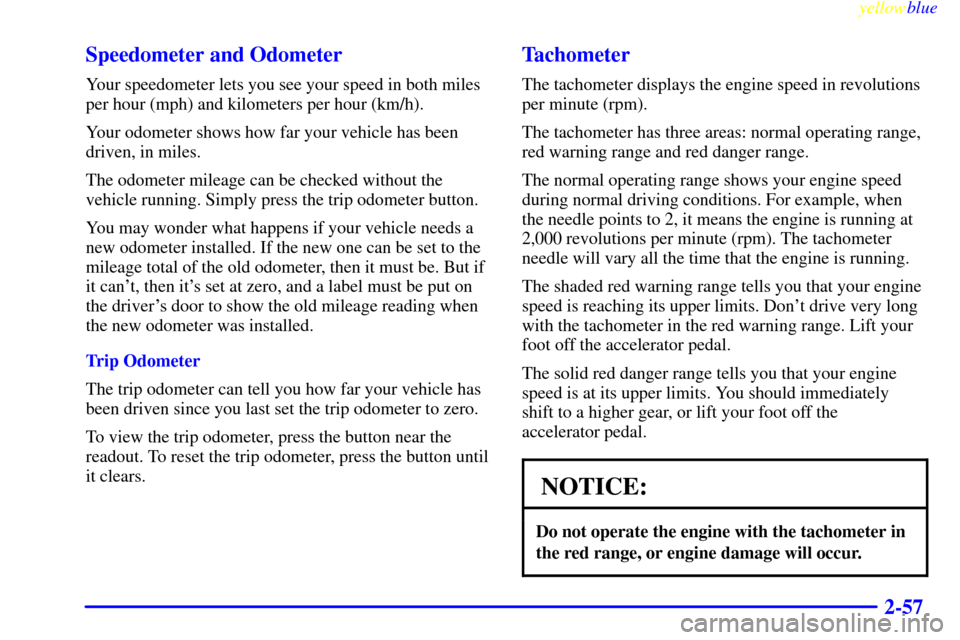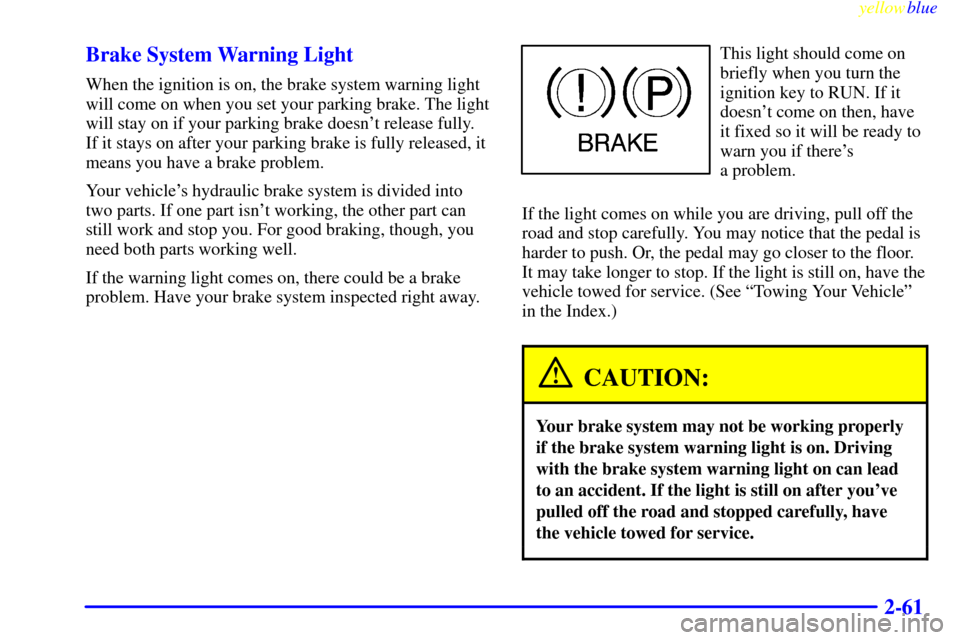Oldsmobile Bravada 1999 Owner's Manuals
Manufacturer: OLDSMOBILE, Model Year: 1999, Model line: Bravada, Model: Oldsmobile Bravada 1999Pages: 368, PDF Size: 2.77 MB
Page 111 of 368

yellowblue
2-53
Note to Canadian Owners: During programming, the
hand
-held transmitter may automatically stop transmitting
after one or two seconds. In this case, you should press and
re
-press the button on the hand-held transmitter every two
seconds without ever releasing the button on the universal
transmitter. Release both buttons when the indicator light on
the universal transmitter begins to flash rapidly.
Operating the Transmitter
Press and hold the appropriate button on the universal
transmitter. The indicator light comes on while the
signal is being transmitted.
If the hand
-held transmitter appears to program the
universal transmitter but does not open your garage door,
and if the garage door opener was manufactured after
1996, the garage door opener may have a ªrolling codeº
system. A rolling code system changes the code of the
garage door opener every time you open or close the
garage door.
To determine if you have this system, press the button
on the universal transmitter that you have programmed
already. If the indicator light flashes rapidly for one to
two seconds, then turns solid, the garage door opener
has a rolling code system. In a rolling code system, the
garage door motor head unit must be trained to the
universal transmitter.
Training a Garage Door Opener with a
ªRolling Codeº Feature (If Equipped)
If you have not previously programmed the hand-held
transmitter to the universal transmitter, see
ªProgramming the Transmitterº listed previously. If you
have completed this programming already, you now
need to train the garage door opener motor head unit to
recognize the universal transmitter. Refer to your garage
door opener owner's manual for the proper transmitter
training procedure for your garage door opener brand.
1. Find the training button on the garage door opener
motor head unit. The exact location and color will
vary by garage door opener brand. If you have
difficulty finding the training button, refer to your
garage door opener owner's manual.
2. Press the training button on the garage door opener
motor head unit. An indicator light will begin to
flash when the motor head unit enters the
training mode.
Note: Following this step, you have 30 seconds to
start Step 3.
Page 112 of 368

yellowblue
2-54
3. Return to the universal transmitter in your vehicle
and firmly press and release the universal transmitter
button you have already programmed for two to
three seconds. Press and release the button again
(you may need to do this step up to three times) to
make sure that the universal transmitter has been
trained to the garage door opener motor head unit.
Check that the training was successful. The motor
head unit indicator light should no longer
be flashing.
The garage door opener should now recognize the
universal transmitter. You may either use the universal
transmitter or the hand
-held transmitter to open the
garage door.
If after following these instructions, you still have
problems training the garage door opener, call the
manufacturer of the unit at 1
-800-355-3515.
Erasing Channels
To erase all three programmed channels, hold down the
two outside buttons until the indicator light begins to
flash (after 20 seconds). Release both buttons.
Accessories
Accessories for the universal transmitter are available
from the manufacturer of the unit. If you would like
additional information, please call 1
-800-355-3515.
Page 113 of 368

yellowblue
2-55
Instrument Panel
A. Air Vents
B. Instrument Cluster
C. Glove Box
D. Audio System
E. Auxiliary Power OutletsF. Rear Window Defogger
G. Comfort Controls
H. Ashtray
I. Rear Liftgate Glass Release
J. Rear Window Washer/WiperK. Audio Steering Wheel Controls
(If Equipped)
L. Brake Release
M. Fog Lamps
N. Lamp Controls
Page 114 of 368

yellowblue
2-56
Instrument Panel Cluster
Your instrument cluster is designed to let you know at a glance how your vehicle is running. You'll know how fast
you're going, about how much fuel you've used, and many other things you'll need to know to drive safely
and economically.
Page 115 of 368

yellowblue
2-57 Speedometer and Odometer
Your speedometer lets you see your speed in both miles
per hour (mph) and kilometers per hour (km/h).
Your odometer shows how far your vehicle has been
driven, in miles.
The odometer mileage can be checked without the
vehicle running. Simply press the trip odometer button.
You may wonder what happens if your vehicle needs a
new odometer installed. If the new one can be set to the
mileage total of the old odometer, then it must be. But if
it can't, then it's set at zero, and a label must be put on
the driver's door to show the old mileage reading when
the new odometer was installed.
Trip Odometer
The trip odometer can tell you how far your vehicle has
been driven since you last set the trip odometer to zero.
To view the trip odometer, press the button near the
readout. To reset the trip odometer, press the button until
it clears.
Tachometer
The tachometer displays the engine speed in revolutions
per minute (rpm).
The tachometer has three areas: normal operating range,
red warning range and red danger range.
The normal operating range shows your engine speed
during normal driving conditions. For example, when
the needle points to 2, it means the engine is running at
2,000 revolutions per minute (rpm). The tachometer
needle will vary all the time that the engine is running.
The shaded red warning range tells you that your engine
speed is reaching its upper limits. Don't drive very long
with the tachometer in the red warning range. Lift your
foot off the accelerator pedal.
The solid red danger range tells you that your engine
speed is at its upper limits. You should immediately
shift to a higher gear, or lift your foot off the
accelerator pedal.
NOTICE:
Do not operate the engine with the tachometer in
the red range, or engine damage will occur.
Page 116 of 368

yellowblue
2-58
Warning Lights, Gages and Indicators
This part describes the warning lights and gages that may be
on your vehicle. The pictures will help you locate them.
Warning lights and gages can signal that something is
wrong before it becomes serious enough to cause an
expensive repair or replacement. Paying attention to
your warning lights and gages could also save you or
others from injury.
Warning lights come on when there may be or is a
problem with one of your vehicle's functions. As you
will see in the details on the next few pages, some
warning lights come on briefly when you start the
engine just to let you know they're working. If you are
familiar with this section, you should not be alarmed
when this happens.
Gages can indicate when there may be or is a problem
with one of your vehicle's functions. Often gages and
warning lights work together to let you know when
there's a problem with your vehicle.
When one of the warning lights comes on and stays on
when you are driving, or when one of the gages shows
there may be a problem, check the section that tells you
what to do about it. Please follow this manual's advice.
Waiting to do repairs can be costly
-- and even
dangerous. So please get to know your warning lights
and gages. They're a big help.
Safety Belt Reminder Light
When the key is turned to RUN or START, a chime will
come on for about eight seconds to remind people to
fasten their safety belts, unless the driver's safety belt is
already buckled.
The safety belt light will
also come on and stay on
for about 20 seconds, then it
will flash for about
55 seconds.
If the driver's belt is already buckled, neither the chime
nor the light will come on.
Page 117 of 368

yellowblue
2-59 Air Bag Readiness Light
There is an air bag readiness light on the instrument
panel, which shows the air bag symbol. The system
checks the air bag's electrical system for malfunctions.
The light tells you if there is an electrical problem. The
system check includes the air bag sensors, the air bag
modules, the wiring and the crash sensing and
diagnostic module. For more information on the air bag
system, see ªAir Bagº in the Index.
This light will come on
when you start your engine,
and it will flash for a few
seconds. Then the light
should go out. This means
the system is ready.
If the air bag readiness light stays on after you start the
engine or comes on when you are driving, your air bag
system may not work properly. Have your vehicle
serviced right away.
The air bag readiness light should flash for a few
seconds when you turn the ignition key to RUN. If the
light doesn't come on then, have it fixed so it will be
ready to warn you if there is a problem.
Charging System Indicator Light
The charging system light
will come on briefly when
you turn on the ignition, but
the engine is not running, as
a check to show you it
is working.
It should go out once the engine is running. If it stays
on, or comes on while you are driving, you may have a
problem with the charging system. It could indicate that
you have problems with a generator drive belt, or
another electrical problem. Have it checked right away.
Driving while this light is on could drain your battery.
If you must drive a short distance with the light on, be
certain to turn off all your accessories, such as the radio
and air conditioner.
Page 118 of 368

yellowblue
2-60 Voltmeter Gage
When your engine is not
running, but the ignition is
on (in the RUN position),
this gage shows your
battery's state of charge in
DC volts.
When the engine is running, the gage shows the
condition of the charging system. Readings between the
low and high warning zones indicate the normal
operating range.Readings in the low warning zone may occur when a
large number of electrical accessories are operating in
the vehicle and the engine is left at an idle for an
extended period. This condition is normal since the
charging system is not able to provide full power at
engine idle. As engine speeds are increased, this
condition should correct itself as higher engine speeds
allow the charging system to create maximum power.
You can only drive for a short time with the reading in
either warning zone. If you must drive, turn off all
unnecessary accessories.
Readings in either warning zone indicate a possible
problem in the electrical system. Have the vehicle
serviced as soon as possible.
Page 119 of 368

yellowblue
2-61 Brake System Warning Light
When the ignition is on, the brake system warning light
will come on when you set your parking brake. The light
will stay on if your parking brake doesn't release fully.
If it stays on after your parking brake is fully released, it
means you have a brake problem.
Your vehicle's hydraulic brake system is divided into
two parts. If one part isn't working, the other part can
still work and stop you. For good braking, though, you
need both parts working well.
If the warning light comes on, there could be a brake
problem. Have your brake system inspected right away.
This light should come on
briefly when you turn the
ignition key to RUN. If it
doesn't come on then, have
it fixed so it will be ready to
warn you if there's
a problem.
If the light comes on while you are driving, pull off the
road and stop carefully. You may notice that the pedal is
harder to push. Or, the pedal may go closer to the floor.
It may take longer to stop. If the light is still on, have the
vehicle towed for service. (See ªTowing Your Vehicleº
in the Index.)
CAUTION:
Your brake system may not be working properly
if the brake system warning light is on. Driving
with the brake system warning light on can lead
to an accident. If the light is still on after you've
pulled off the road and stopped carefully, have
the vehicle towed for service.
Page 120 of 368

yellowblue
2-62 Anti-Lock Brake System Warning Light
With the anti-lock brake
system, this light will come
on when you start your
engine and may stay on for
several seconds.
That's normal.
If the light stays on, or comes on when you're driving,
your vehicle needs service. If the regular brake system
warning light isn't on, you still have brakes, but you
don't have anti
-lock brakes. If the regular brake system
warning light is also on, you don't have anti
-lock brakes
and there's a problem with your regular brakes. See
ªBrake System Warning Lightº earlier in this section.
The anti
-lock brake system warning light should come
on briefly when you turn the ignition key to RUN. If the
light doesn't come on then, have it fixed so it will be
ready to warn you if there is a problem.
Engine Coolant Temperature Gage
This gage shows the engine
coolant temperature. If the
gage pointer moves into the
red area, your engine is
too hot!
It means that your engine coolant has overheated. If you
have been operating your vehicle under normal driving
conditions, you should pull off the road, stop your
vehicle and turn off the engine as soon as possible.
The ªProblems on the Roadº section of this manual
shows you what to do. See ªEngine Overheatingº in
the Index.